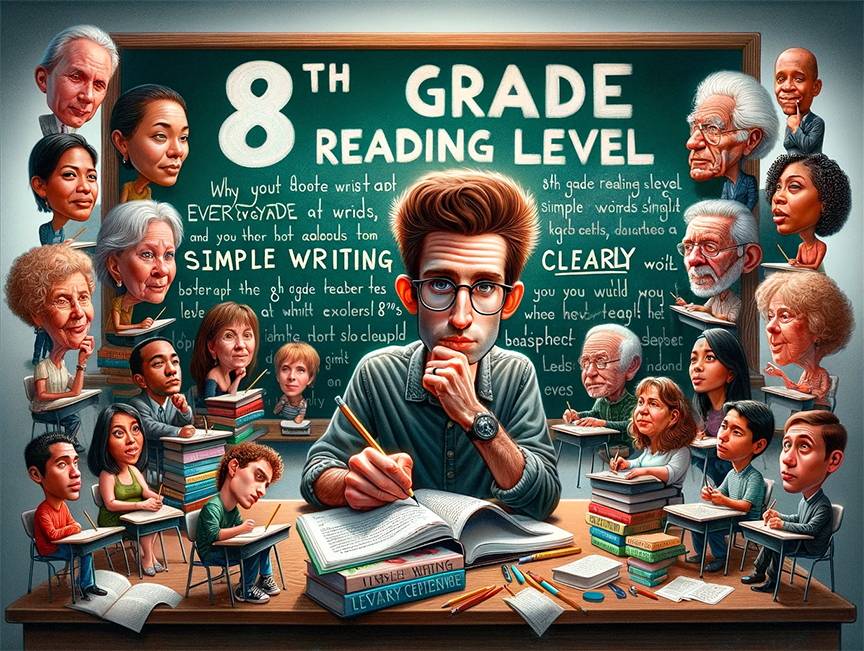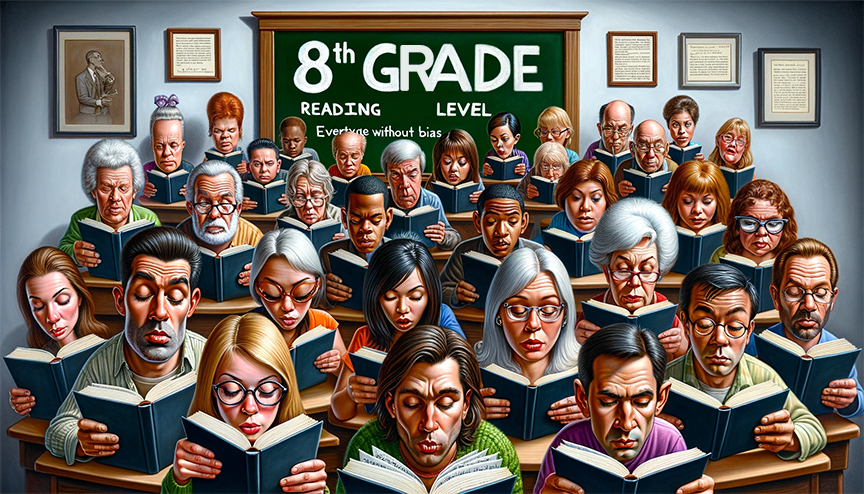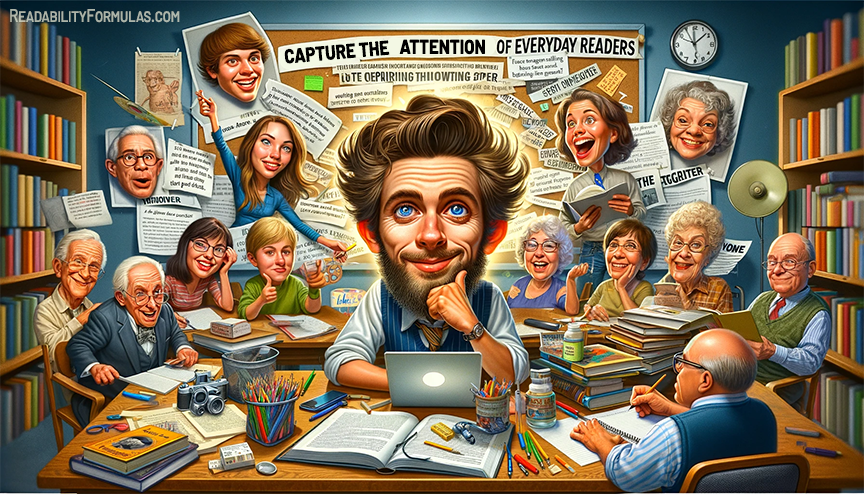 Creating content that everyday readers can understand is as important—or maybe even more important—as writing for a niche audience of college graduates. And who are these everyday readers? They are you, and me; they are young readers and adult readers. They are students, workers, entrepreneurs, doctors, accountants, and everyone else. When you don’t know your target readership—the layperson or the highly-educated adult—or you need to communicate to a broad and diverse audience, target everyday readers. The most effective way to engage everyday readers is to write at an “8th grade reading level.” This, of course, is the educational level of an average 8th grade student around 13 to 14 years old. At this stage, readers have grasped the basics of reading and writing but still face difficulties with grammar, vocabulary, sentence structure and the like.
Creating content that everyday readers can understand is as important—or maybe even more important—as writing for a niche audience of college graduates. And who are these everyday readers? They are you, and me; they are young readers and adult readers. They are students, workers, entrepreneurs, doctors, accountants, and everyone else. When you don’t know your target readership—the layperson or the highly-educated adult—or you need to communicate to a broad and diverse audience, target everyday readers. The most effective way to engage everyday readers is to write at an “8th grade reading level.” This, of course, is the educational level of an average 8th grade student around 13 to 14 years old. At this stage, readers have grasped the basics of reading and writing but still face difficulties with grammar, vocabulary, sentence structure and the like.
According to the National Assessment of Adult Literacy, around 43% of American adults have basic or below-basic literacy skills.
Writing at an 8th grade reading level is a proven way to capture every type of reader without bias. It’s significant for non-native English speakers, too. Using simpler language and clear explanations helps to overcome learning and language barriers; we make our content more inclusive and comprehensible. Additionally, writing at this level can benefit individuals with reading difficulties or disabilities. A straightforward and concise writing style enhances accessibility and enables everyone to engage effectively with your content.
Research conducted by Nielsen Norman Group found that the average online reader comprehends only about 60% of the content they read.
Understanding the 8th Grade Readership Level
Let’s consider some real-world examples to grasp two key points: simplicity and clarity.
- Science Articles
Imagine you’re writing a science article about photosynthesis for adult readers. Instead of using complex scientific terms, you could explain it like this: “Plants make their own food using a process called photosynthesis. They use sunlight, water, and carbon dioxide to create energy and release oxygen.” - News Articles
Let’s say you’re writing a news article about a current event. Instead of lengthy sentences and technical jargon, you could write a clear and concise headline like this: “New Technology Helps Clean Up Ocean Pollution.” - Social Media Posts
Imagine you’re creating a social media post to engage with a diverse audience. Instead of using complex language and lengthy sentences, you could write a simple and engaging message like this: “📢 Exciting news! Our new store is now open! Come and check out the latest trends and amazing deals. See you there! #GrandOpening #FashionFinds“ - Health and Wellness Blog
Suppose you’re writing a blog post about the benefits of exercise. Instead of using technical terms that specialists only know, you could explain it in a relatable way: “Moving your body through exercise is like giving your heart and muscles a workout. It helps you stay strong, feel energized, and even boosts your mood. So, let’s get active and have some fun!“ - Travel Guide Description
Imagine you’re writing a travel guide description for a popular tourist destination. Instead of using complex descriptions, you could write a short, enticing summary like this: “Welcome to Paradise Island! With its white sandy beaches, crystal-clear waters, and vibrant marine life, this tropical paradise offers a perfect getaway. Enjoy snorkeling, sunbathing, and unforgettable sunsets.“ - Recipe Instructions
When providing recipe instructions for a delicious homemade pizza, keep it simple and clear: “Spread pizza sauce on the dough. Sprinkle cheese and your favorite toppings. Bake at 400°F for 12-15 minutes or until golden brown. Enjoy your homemade pizza!“ - Product Description
When describing a new smartphone in a product brochure, focus on key features without overwhelming technical details: “Introducing our latest smartphone! Enjoy a stunning display, fast performance, and a high-resolution camera that captures beautiful memories. Stay connected and explore the world of apps effortlessly.” - How-To Guide
When writing a how-to guide on assembling a piece of furniture, break it down into easy-to-follow steps: “Step 1: Lay out all the parts and tools. Step 2: Follow the instruction manual and connect pieces A and B. Step 3: Attach pieces C and D using screws. Repeat for remaining parts. Step 4: Secure the completed sections together. Voila! Your furniture is assembled!“ - Safety Instructions
When providing safety instructions for using household appliances, focus on clear and concise guidelines: “To operate the microwave safely, place food inside, set the desired time, and press start. Always use microwave-safe containers and avoid heating metal objects. Never leave the microwave unattended during use.” - Event Announcement
When announcing a school event in a newsletter, provide essential details in a straightforward manner: “Save the date! Our school’s annual talent show will take place on Friday, June 15th, at 6:00 PM in the auditorium. Come cheer on your classmates as they showcase their amazing talents!“
In these examples, we use simple language and avoid unnecessary complexity.
The American Press Institute states that most news articles in the United States are written at a 7th- to 8th-grade reading level.
Engaging Readers and Maintaining Interest
To keep everyday readers engaged, we need to know how to capture their attention.
- Captivate: Begin with a captivating introduction. Use a compelling question, an interesting fact, or a relatable anecdote to grab readers’ attention from the start. This sets the tone and makes them eager to continue reading.
- Clear and Concise Language: Use clear and concise language to convey your message effectively. Avoid unnecessary details or complex explanations. Don’t confuse or bore readers. Be direct and get straight to the point. Ensure readers can easily understand your ideas.
- Visual Aids and Multimedia: Use visual aids, such as images, charts, or diagrams. Visual elements help readers visualize concepts, making the information accessible and memorable. Use multimedia elements like videos or interactive content to increase engagement.
- Dissect: Present information in smaller, digestible chunks. Use subheadings, bullet points, or numbered lists to organize your content. Breaking down complex ideas into simpler parts helps readers to follow along and comprehend the information.
- Foster Interaction: Encourage readers to interact with the content. Ask questions, provide opportunities for reflection, or include interactive elements like quizzes or polls. This creates an active reading experience.
A study published in the Journal of Applied Psychology found that employees who receive written instructions at a lower reading level perform better and make fewer errors than those who receive complex instructions.
How to Communicate Complex Ideas Effectively
Don’t overwhelming everyday readers with complex ideas. Here’s how.
- Simplify without Oversimplifying: When presenting complex ideas, strive for simplicity without sacrificing accuracy. Dissect intricate concepts into manageable pieces. Use clear language to explain them. Avoid unnecessary technical terms or jargon; provide relatable examples or comparisons instead.
- Organize Information: Organize your content in a logical and structured manner. Use headings, subheadings, or numbered points to create a clear flow of information. Help readers follow your ideas and grasp the connections between different concepts.
- Use Analogies and Metaphors: Analogies and metaphors can be powerful tools for conveying complex ideas in a relatable way. Compare unfamiliar concepts to familiar ones, making them easier to understand. For example, explaining a computer’s memory as a “virtual filing cabinet” helps readers grasp the concept more easily.
- Provide Context and Background: Before diving into complex ideas, provide readers with the necessary context and background information. Briefly explain the relevant background knowledge. Help readers improve their understanding so they can grasp the complexities of the topic.
- Reinforce Key Points: Repetition and reinforcement are essential for understanding and retention. Summarize key points throughout your writing, emphasizing their importance. Reinforce the main ideas to help readers remember the key takeaways.
A study by Labrador and BVA Group revealed how people feel when they read text written in plain English. They found a clear result: text written simply is more enjoyable to read. They identified four main benefits of using simple language:
- Faster Reading: People can read a 100-word paragraph in simple language in less than 30 seconds–this is 50% faster than more complex text. This was true for 60% of the participants.
- Quicker Understanding: Readers are 38% more likely to understand text in simple language. This approach combines efficiency and clarity, ensuring that reading speed does not impact understanding.
- Improved Message Retention: The study found that 41% more readers retained key information from text written in simple language.
- Clarity: 64% of readers thought text in simple language was well-written. And 34% more people found it well-organized, helping them to engage more easily with the message.
How to Connect with Your Audience
It’s important to build a strong connection with your audience. Here’s how:
- Establish Trust and Credibility: Provide accurate information and reliable sources. Clearly state your expertise or qualifications on the topic. This will build confidence and establish trust, making readers more receptive to your message.
- Understand Readers’ Needs: Put yourself in your readers’ shoes and understand their needs and interests. Consider what information they are seeking and how you can address their questions or concerns.
- Use Relatable Writing: Write in a relatable and conversational tone to engage your readers. Avoid overly formal or technical language. Instead, use everyday language that your readers can easily understand and connect with. This creates a friendly and approachable atmosphere.
- Address Reader Questions: Anticipate and address reader questions within your writing. Think about potential areas of confusion. Provide clear explanations.
- Encourage Interaction: Encourage readers to engage with your content by posing questions or inviting them to share their thoughts. Incorporate opportunities for feedback, comments, or discussion. Make your readers feel valued.
The Plain Language Action and Information Network (PLAIN) reports that 36 million adults in the U.S. have limited reading skills, highlighting the need for clear and simple communication.
Writing for everyday readers is not about dumbing down your writing; it’s about smart writing: cleverly using concise and succinct words that don’t alienate readers or make them struggle to read your message.










